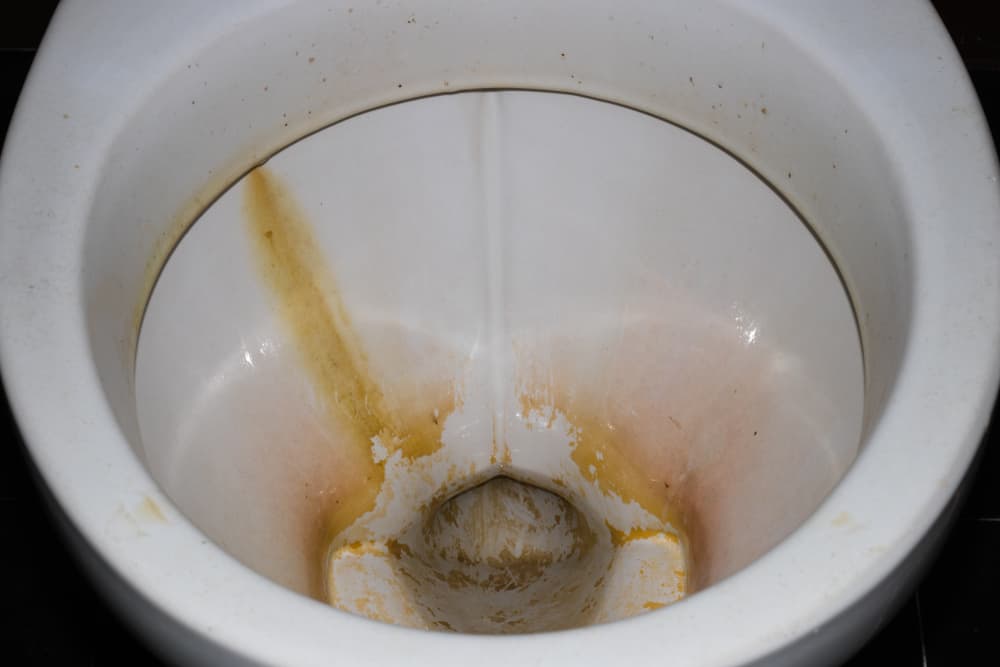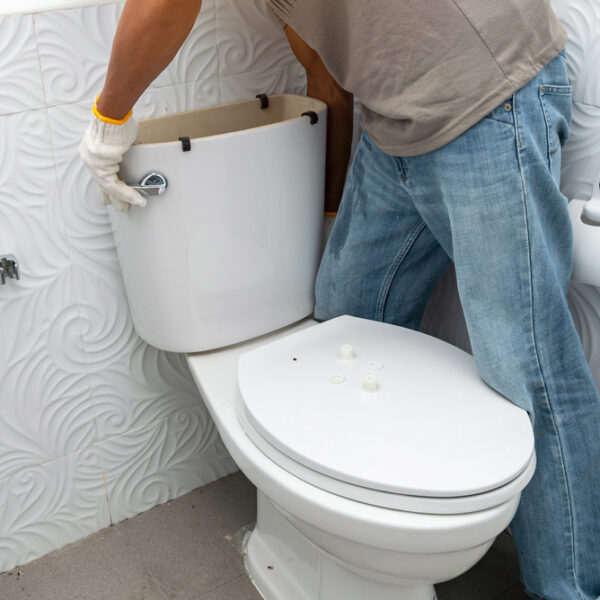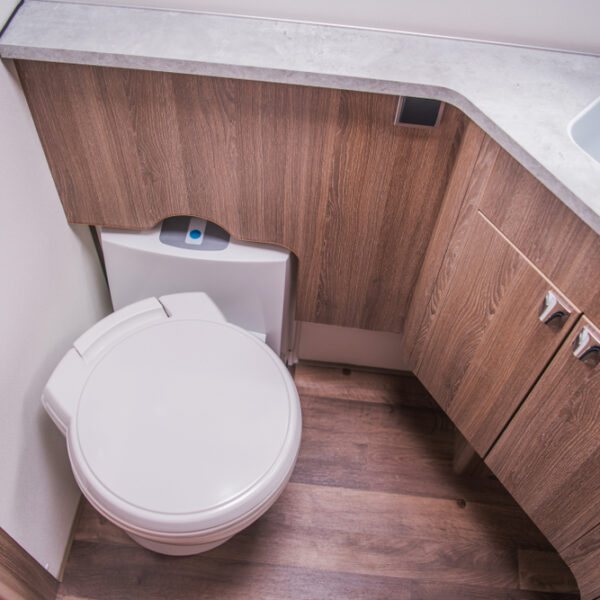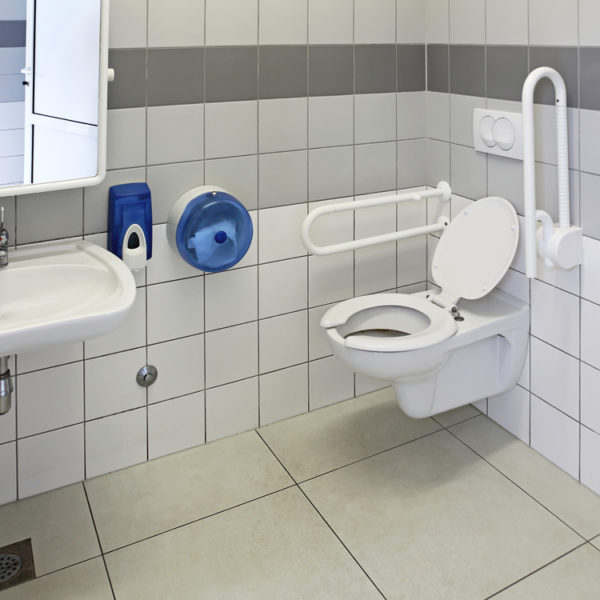Nobody likes to see a dirty toilet with a stained yellow bowl, and if you notice the one in your home changing color like this, you’re sure to want to do something about it. It’s unpleasant enough for you, but if guests come to visit, it can be highly embarrassing if they see it too.
There are several reasons why toilets turn yellow, but fortunately, there’s usually something you can do to rectify the problem short of buying an expensive new toilet. So here, we tackle issues like this as we answer the question, what causes yellow stains on a toilet bowl?
Identify Causes of Yellow Stains on a Toilet Bowl
If you notice your toilet becoming discolored and developing a yellow tinge, the first thing you need to do is identify the cause since this will help you choose the best way to remove the stain. Here are some of the most common reasons:
1. Urine
One of the most common causes of toilet seat stains and toilet bowls turning yellow is urine.
If you keep your toilet clean, urine stains shouldn’t develop, but if urine is left on the toilet without being cleaned off, it can cause discoloration.
Urine contains a chemical called urobilin – also known as urochrome – and this is the pigmentation that makes it yellow. If it is left on the toilet seat or in the toilet bowl, it will also cause stains that can be tough to remove.
2. Hard water
Another common cause of staining in toilet bowls and on toilet seats is hard water. Hard water contains minerals like calcium and magnesium, and over time, these minerals can build up into a limescale deposit.
When this occurs, the deposit will gradually stain your toilet yellow or yellow-brown.
3. Sunlight
If your toilet is located in direct sunlight, the UV rays from the sun will gradually cause the color of your toilet to fade or take on a yellow hue.
Unfortunately, if this happens, there’s little you can do about it since the sun’s rays have changed the color of the toilet material rather than just stained the surface.
4. Age
Even toilets that are not in direct sunlight will slowly lose their color and begin to take on a dirty yellow aspect with time. Again, there’s not much you can do either to prevent this or resolve the issue once it happens.
How to remove a Yellow stained toilet bowl?
If your toilet bowl or seat develops a yellow stain, there are several cleaners you can try before resorting to buying a new toilet. Here are some of the most popular:
Vinegar
A simple, inexpensive method that isn’t harmful to the environment. Vinegar contains acetic acid, which is what makes it useful for a wide range of cleaning tasks – including removing stains from toilets.
Bicarbonate of soda
Another inexpensive yet effective method that doesn’t require the use of strong chemicals. It is also sometimes known as baking soda.
Lemon juice and essential oils
Lemon juice contains citric acid, which can work well for removing stains. It’s also natural, so it’s a good choice for people who don’t want to use chemical products, making a cup of lemon juice a natural and affordable solution.
The pleasant smell of the lemon and the essential oils will also work as a natural air freshener.
Borax powder
A more powerful option for more stubborn stains. You’ll need to visit a hardware store to buy borax powder since most regular supermarkets don’t sell it.
Trisodium phosphate
Like borax powder, this is another powerful cleaning agent that you can try if other methods aren’t working.
Chlorine bleach
If you can’t shift a stain, a more extreme method is to try using chlorine bleach. However, you need to be careful not to use too much because undiluted bleach can cause stains itself.
Step by Step Guides
Now let’s have a look at how to use some of these cleaners in a bit more detail.
How to get yellow stains out of toilet bowl with Vinegar?
What you need:
- White vinegar
- Spray dispenser
- Cloth or toilet brush
How to do it:
- Spray vinegar onto stain
Put the vinegar into the spray dispenser and spray it onto the stained area of the toilet bowl. If the affected area is under the water in the toilet, you will need to remove the water first.
If you don’t know how to remove water from a toilet, here’s a short video showing you how it’s done.
- Leave for around half an hour
Once you have applied the vinegar to the stained area using the spray dispenser, leave it for around half an hour or so for it to do its thing.
- Wipe clean with brush or cloth
Once the vinegar has done its work, simply wipe it off using a piece of cloth, a toilet brush or a sponge and then rinse. You should already see a big improvement.
- Repeat
If the stain hasn’t completely disappeared, repeat the process once or twice more. This should clean up most light to moderate stains on toilet bowls or toilet seats.
How to remove yellow stains from toilet bowl with Bicarbonate of soda
What you’ll need:
- Bicarbonate of soda
- Cup or mug
- Old wooden spoon (optional)
- Water
- Cloth or brush
How to do it:
- Mix up a paste of bicarbonate of soda and water
Start by mixing up a paste of bicarbonate of soda and water in a cup or mug. The ratio should be 2:1 bicarbonate of soda to water.
- Apply to the stained area
Apply the paste to the stained area. You can do this with your finger – or you can use an old wooden spoon if you prefer not to touch the toilet with your hand.
You may need to remove the water from the toilet bowl as explained above if the stain is below the water level.
- Leave for half an hour
Leave the paste on the stain for at least half an hour to allow it to take effect.
- Clean off the paste with a cloth or a brush
Clean off the paste with a cloth or brush and see if it has worked.
- Repeat as necessary
For best results, you can repeat the process once or twice for more stubborn stains.
Lemon juice with essential oils, borax powder, trisodium phosphate
The technique for the other options is similar. All you need to do is apply each cleaning agent to the stain, leave them to have their effect if necessary and then wash them off.
For lemon juice, squeeze the juice from one whole lemon into a cup, add a few drops of essential oil and use this solution to clean with.
Borax powder should be sprinkled onto the stained area, brushed in with a gentle brush and then left to take effect.
For trisodium phosphate, mix one tablespoon with a gallon (4 liters) of warm water and then use this liquid to wash the stained areas. With this technique, there is no need to leave the cleaning agent on the toilet bowl before rinsing it off.
Bonus Tips
Here are some tips that will help ensure you achieve optimum results.
- Use soda and vinegar together
For an even more powerful yet still harmless cleaning agent, use white vinegar instead of water to mix with the bicarbonate of soda to make your paste. Use the same 2:1 ratio.
- Don’t use a stiff brush to scrub
Don’t use a stiff brush to clean your toilet, especially if you are trying to remove a stain from the seat.
A stiff brush is abrasive and will scratch your toilet if you use it to scrub, so while you may manage to remove the stain, you will end up with permanent scratch marks on your toilet, which is hardly any better.
- Use bleach to soak a stained toilet seat
If your toilet seat is stained, you can try soaking it in bleach to remove the yellow color.
To do this, you’ll need a container that’s large enough to fit the whole toilet seat – a regular bucket won’t be big enough.
Remove the toilet seat from the toilet and submerge it in a mixture of bleach and water – check the instructions on the bleach to find out how much to use.
Make sure you dilute it enough, however, since pure or strong bleach can damage your toilet seat.
- Wear rubber gloves
It’s always a good idea to wear rubber gloves when removing stains from a toilet, whichever method you choose. This will avoid you getting nasty bacteria on your hands, and it will also protect your skin from any harmful substances you are using to clean the toilet.
- Pink or orange stains
Sometimes you may notice pink or orange stains in your toilet bowl, on the toilet seat or in other parts of your bathroom.
These are caused by a type of bacteria rather than by urine or limescale, but if you spot them, you can try using the same techniques to get them off.
When you spot pink stains, you should wash them off as early as possible since if you leave them too long, they can damage parts of your bathroom and will become extremely difficult to remove.
- Use Coke
Using Coca-Cola as an ingredient for stain removal is also surprisingly effective. Simply pour it over the stained area or soak a cloth in it and place the cloth over the stained area. Leave it to act and then wipe the toilet clean.
Prevention is better than cure
Of course, the old adage that prevention is better than cure is as true as ever, so what can you do to ensure your toilet bowl or seat doesn’t turn yellow in the first place?
One of the first steps you can take is to make sure you keep your toilet clean at all times.
Make sure no splashes of urine are left on the seat or the bowl after each use and clean the toilet properly once a week. This will help prevent stains from urine from developing.
Also, keep an eye out for limescale deposits. Sometimes, limescale builds up so slowly that it’s almost imperceptible to the person living there.
However, if you spot limescale starting to develop on your toilet, clean it off as early as possible to prevent any stains from developing.
Generally speaking, proper regular cleaning and maintenance of your toilet will prevent most stains from developing.
If your toilet is situated in direct sunlight, it can be hard to prevent damage from the sun’s rays. However, you can consider installing curtains or blinds to protect your toilet and the rest of your bathroom from direct sunlight.
Prevent stains from appearing and act as soon as you notice them
There are a few reasons for toilet bowls to develop yellow stains, and understanding why they occur can help you prevent them from appearing in the first place and aid in removing them if they do appear.
If you notice stains on your toilet seat or bowl, the key is to clean them off as quickly as possible using one of the techniques we’ve outlined above. This way, they won’t become too serious and will be easier to remove without too much effort.












